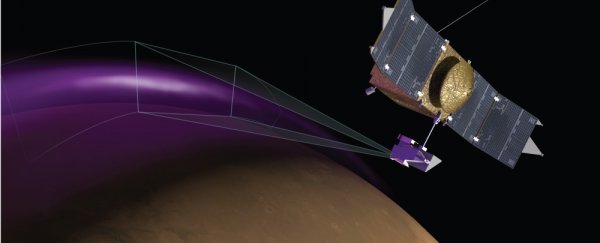It's been a big week for the skies, with pretty much all of us who live remotely close to a pole scanning for signs of super-powerful aurorae, or preparing to witness the solar eclipse. And over at NASA, researchers reported that their MAVEN probe had spotted an aurora glowing over Mars in mid-December last year - and it's like nothing seen on the Red Planet before.
Aurorae are caused when charged particles that have been blasted out of the Sun interact with a planet's atmosphere. On Earth, these light up the skies above the north and south magnetic poles, but on Mars, scientists have only ever seen aurorae over the Red Planet's southern hemisphere, where the magnetic field is the strongest.
However, this newly described aurora, which researchers are calling the "Christmas lights", as it was spotted between the 8th and 23rd of December last year, occurred all across the northern hemisphere, and at far lower altitudes than any previous aurorae.
"We're seeing it not connected to magnetic regions," the MAVEN mission leader, Bruce Jakosky, told New Scientist. "We don't know if it is occurring only at the places we're observing, or if it is globally distributed."
Around the same time, the Sun was pouring out electrons at high enough energies to penetrate the Martian atmosphere, as Jacob Aron explains for New Scientist. So it's likely that this played a role in triggering the strange event, but so far the team has no answers for exactly how it occurred.
The MAVEN probe is now lining up to look at the entire northern hemisphere of the Red Planet in the hopes of finding some answers.
Source: New Scientist
